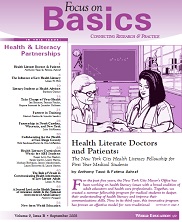For this issue of Focus on Basics we assembled a team of editors who represent both sides of the health and literacy partnership, including a doctor, a medical librarian, a professor of adult education who works in health and literacy, and a literacy specialist new to health and literacy. As a group we experienced many of the same challenges you face as you forge health and literacy partnerships. We asked each other: "What does this mean?" "What does this stand for?" "Would this be of interest to your colleagues?" "Does this ring true?" We started with the view that health literacy is the responsibility of everyone—the medical establishment, literacy providers, and individuals with limited or not so limited literacy—and we found that theme conveyed in all the articles we edited.
For a review of the link between poor health outcomes and low health literacy, turn to Lilian H. Hill's article on page 8. Then explore the partnerships being carried out around the country. Their sheer variety is exciting. In our cover article, authors Anthony Tassi and Fatima Ashraf describe a project of the Mayor's Office of New York City that brings medical students into adult literacy classrooms. In Cambridge, Massachusetts, the Cambridge Health Alliance works with the Cambridge Literacy Center to train adult literacy students to present health information in literacy programs and in community settings (see page 10).
Ian Bennett, Pamela Pinder, Regina Szesniak, and Jennifer Culhane write about the evolution of their Philadelphia-based collaboration, now a home-based model that connects teachers from the Center for Literacy with new mothers to help them gain literacy and health navigation skills and knowledge (see page 14).
In California, Maricel Santos and Lynette Landry of San Francisco State University have teamed up to create a graduate level course that deliberately prepares literacy teachers and nurses in training to contribute to collaborations between the health and literacy fields. Read about their course in the article that starts on page 21, then travel down the coast to learn about a partnership between two umbrella organizations, one for health and one for literacy, that came together to devise a health literacy agenda for San Diego County. Kelli Sandman-Hurley and Chris McFadden write about the process these organizations went through to develop the agenda and the steps being taken to implement it (page 30).
Susan Levy and colleagues share findings from five years of research conducted in Illinois in the article that starts on page 33. They tested whether adult literacy students' literacy skills and health knowledge would improve if teachers used a curriculum that incorporated health content. Julie McKinney reports on three partnerships — in North Carolina, in Wisconsin, and in New York — and the lessons that can be learned from them (page 26).
Researcher Andrew Pleasant challenges us to rethink the way we conceptualize health literacy and demonstrates how data from the National Assessment of Adult Literacy can be interpreted to tell a variety of stories. Turn to page 46 for his insights.
Literacy and health practitioners charged with developing health communication materials will be thrilled to have Lilian H. Hill's review of the role of visuals in health communication materials (see page 40). She distills key lessons from a multitude of studies and provides just the right visuals to show us what she has learned.


